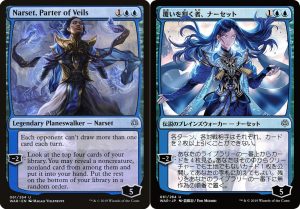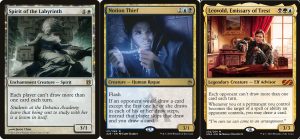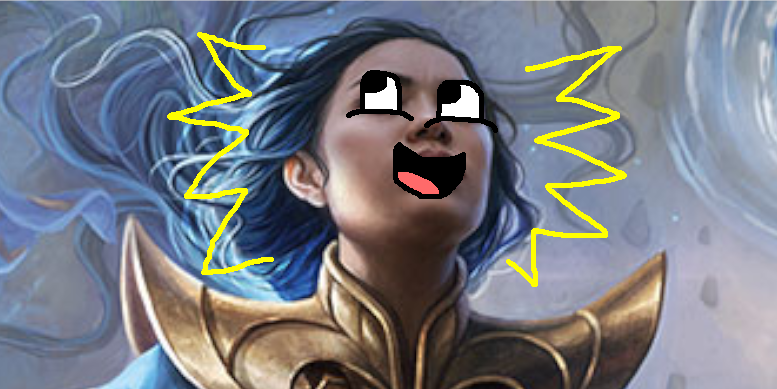Hey there! I’m Scott from the top four of last year’s Great Designer Search 3. Welcome back to the second of three articles on potential planeswalker mistakes in War of the Spark.
Last time we talked about Teferi, Time Raveler, and this week we’ll be talking about another gut-wrenching card:
#2. Narset, Parter of Veils
Even if she is your waifu, it’s important to recognize when you’re in an unhealthy relationship.

Similar to Teferi, Narset can end the game on turn three against certain strategies. If you have a control deck, a deck with cantrips, or even value creatures, having Narset resolve across from you could be lights out.
Hope you don’t have any of these in your hand!

Overall, I think there are two main problems with Narset: (1) her being overpowered compared to other similar cards, and (2) her not necessarily accomplishing what Play Design wants her to do.
Let’s take a look at each issue individually.
1. Lockout AND card advantage?
Narset’s compares extremely favorably to other cards that do similar things. Let’s take a look at three of the most well-known:

- She is far better than Spirit of the Labyrinth. Not only is Spirit an easily-killable creature, but Spirit also shuts down your draws too, not just your opponent’s.
- She is better than Notion Thief. Thief is an easily-killable creature, costs four, and its card advantage is harder to trigger than Narset’s.
- She is arguably better than Leovold, which is scary since Leovold is an extremely powerful card in Legacy. Both Narset and Levold provide card advantage in addition to the lockout, but Narset’s isn’t dependent on the opponent, and since she is mono-blue she is far more flexible.
Narset both locks out your opponent and simultaneously draws you cards. Not only is your opponent cut off from finding answers to Narset, but you also get to search eight cards deep over two turns to find whatever you need.
Usually, cheap cards that can lock out the opponent don’t come with extra utility/card advantage. For example, here’s three cheap cards that can shut down certain strategies…

…and here they are with extras attached.



I know the “updated” versions are ridiculous, but that’s to illustrate the point: cheap lockout plus utility/card advantage is brutal. And that’s even with them still affecting all players, not just your opponents like Narset.
Adding utility/card advantage to cheap cards that can lock out opponents makes the cost of playing them so low that there’s little incentive not to. You can get free random wins in matchups where you lock out your opponent, and in matchups where you don’t, you can still get good use out of them.
Narset does both of these, and she does them both too well: locking out strategies too well, and digging too deep to find more gas.
2. Play Design’s objectives?
Melissa DeTora from Magic R&D’s Play Design team recently wrote an awesome article where she answered a lot of common questions. She even discussed Narset in it, saying:
For example, we knew there was a real possibility that Hydroid Krasis would be very strong in Standard. Since its triggered ability can’t be countered, we wanted an effect that could naturally stop it. We put that effect on Narset, Parter of Veils. Narset is a narrow card in general, but its static ability is very powerful in the right metagame. … If Gruul and White Weenie begin taking over, Narset may move to sideboards.
I think the spirit behind Melissa’s answer is fantastic: always having answers for certain strategies is a part of good Magic. We all remember how miserable standard was when Aetherworks Marvel and Felidar Guardian were everywhere, because there were almost no answers for them.

But I think there’s a big difference between an answer and a hoser. If a card answers a strategy too well, then it’s in danger of warping the entire format around it.
For example, here’s three cards that are good answers to certain strategies…

…and here they are as overpowered hosers.



The reason the original versions are good answers is because they’re powerful against certain strategies, but they don’t end the game on the spot. They get cast, get their two-for-one/efficient value, and then the game continues. They don’t stick around locking out the opponent, which is what Narset does too often and too easily.
New Narsets!
So, can we create some new versions of Narset that (1) aren’t overpowered, and (2) achieve Play Design’s goals?
I think Narset could be easily changed by just ramping her up to four/five mana instead of three, but let’s try and get a little more creative!

This Narset puts a tax on extra cards drawn by the opponent. Paying extra for Hydroid Krasis or Chart a Course makes the cards worse, keeping in line with Play Design’s goal, but at least makes them castable.
I also tweaked her -2 text, only letting her find instants or sorceries. Narset finding any nonland noncreature feels too easy deckbuilding-wise, and limiting it would have her slot into fewer decks.

Now we’re having some fun!
Narset, The Bountiful is a much weaker version of an ability we’ve seen before on Consecrated Sphinx, and while it punishes card draw from the opponent, it doesn’t completely shut it down. I also like how the minus ability on this version plays with the static rather than feeling completely unrelated.

Narset, Draw Absorber is a trickier version. It turns your opponents’ draws into charge counters, drawing a card an extra card each turn she sticks around, digging deeper and staying around longer the more your opponent draws. Again, it takes advantage of your opponent’s extra card draw in a way that’s fun for you rather than miserable for them.

And this one is just for fun. It doesn’t solve the problems that Play Design wanted, but it’s just to show what a more realistic uncommon mono-blue planeswalker could look like. It doesn’t have to be a multi-format game-changer, it can just be a fun card that slots into some decks.
These three are all uncommons too, and they’re at just the right level of doing cool things while not breaking formats in half.

Overall, I want to end with another quote from the Play Design article about Narset in modern/legacy:
Doing this [making Narset available in modern/legacy] creates churn in an environment. Maybe players add more creatures to their decks to attack planeswalkers, play a different removal suite, or avoid playing cards that get hosed by these effects.
I feel like this is a dangerous rabbit hole. Sure, players will always adapt to metagame shifts, but is it being shifted for healthy reasons?
Blood Moon, Choke, and Ensnaring Bridge already exist in modern/legacy, and do they prevent people from playing nonbasics, island, or creatures?
Not really. Instead, those three cards just create random non-games. Blood Moon has locked me out of the game plenty of times when I play blue/white control in modern with ten basics in my deck, and that’s what it feels like Narset does too: it randomly ends the game on turn three. Being able to do that, especially with a maindeckable card, is just no fun.
Instead, making cards that are good against certain strategies — and causing minimal splash damage — feels like a better goal.

Anyway, we’ll be back next week for the last in the planeswalker mistake series. Turns out that with this last guy, the road to hell is paved with silver.
